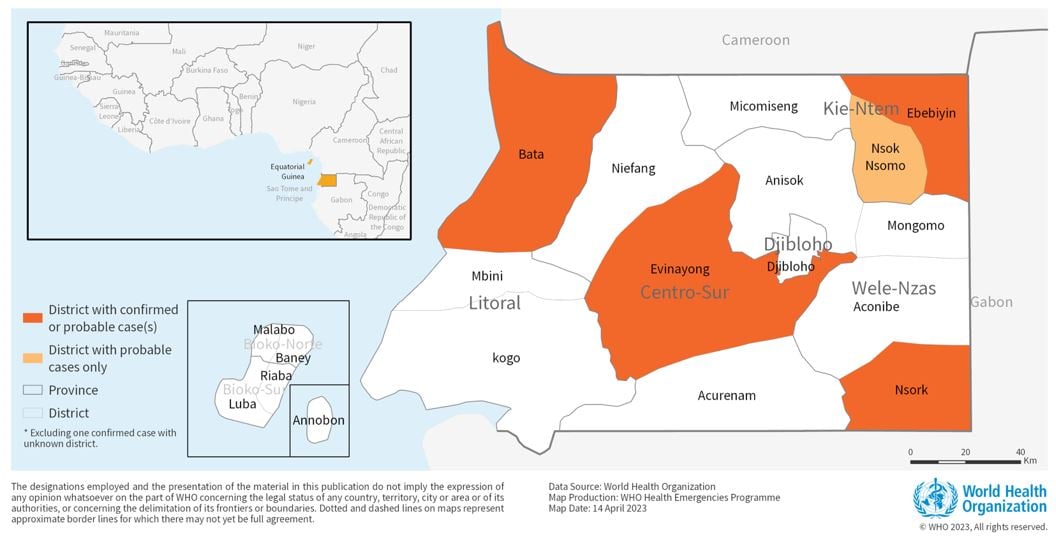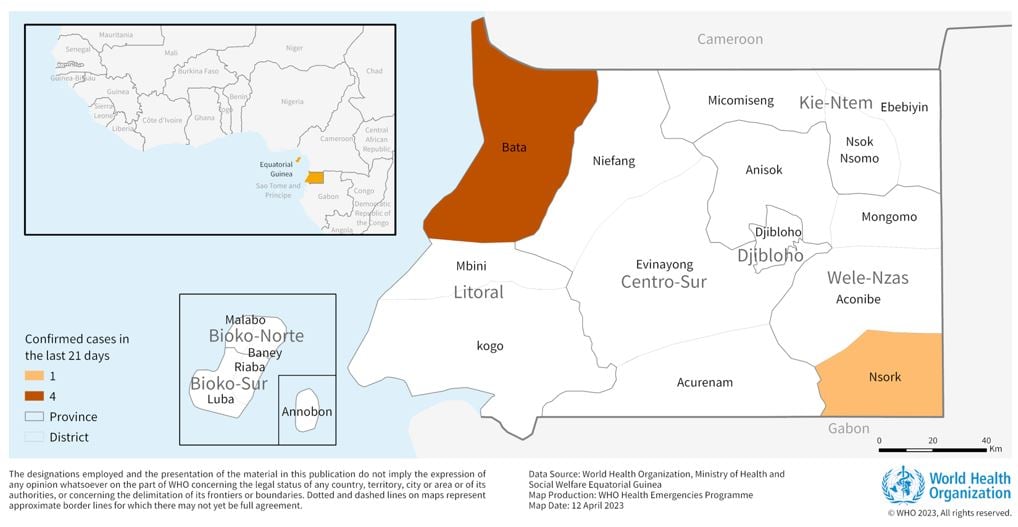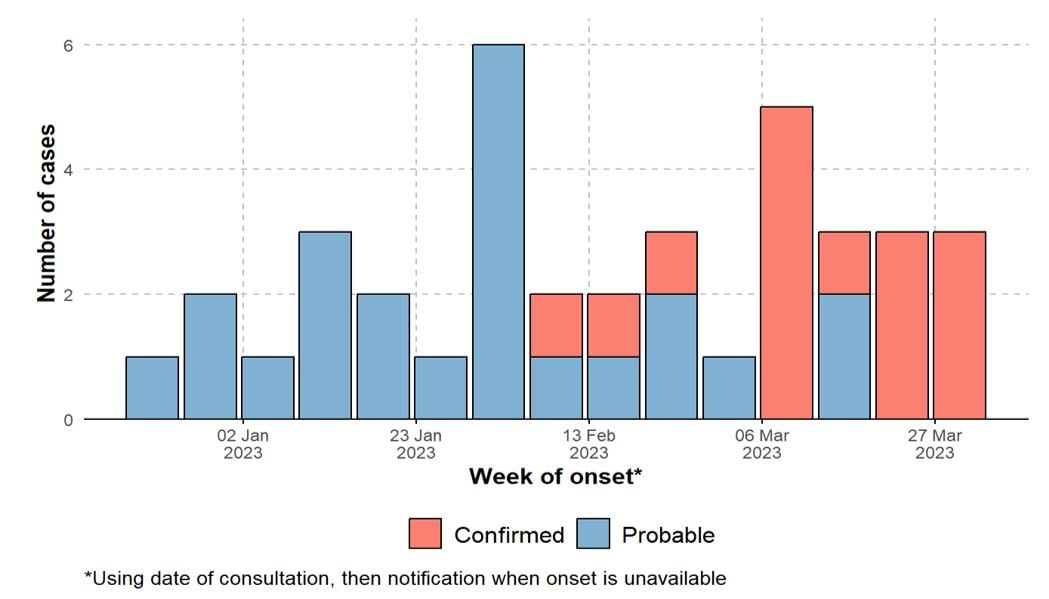The situation at a glance
Since the last Disease Outbreak News about this event was published on March 22, 2023 (with data as of March 21, 2023), six additional laboratory-confirmed cases of Marburg virus disease (MVD) have been reported in Equatorial Guinea. This brings the total to 15 laboratory-confirmed cases and 23 probable cases since the outbreak was declared on February 13, 2023. AAmong the confirmed labs, there are 11 deaths (case fatality rate 78.6%; for one confirmed case, the outcome is unknown) and all probable cases have died. The most affected district is Bata in the Litoral province, with nine laboratory-confirmed cases of MVD reported.
WHO supports the Ministry of Health in strengthening different pillars of the response, including but not limited to surveillance, including at points of entry; laboratory; case management; infection prevention and control; risk communication and community engagement.
MVD is a high mortality disease that causes hemorrhagic fever and is among the diseases that require evaluation under the International Health Regulations.
On March 30, 2023, WHO assessed the public health risk posed by this outbreak as very high at the national level, high at the sub-regional level, moderate at the regional level and low at the global level.
WHO advises against restrictions on international travel and/or trade in Equatorial Guinea.
Description of the situation
On February 13, 2023, Equatorial Guinea’s Ministry of Health and Social Affairs declared an outbreak of Marburg virus disease (MVD) after suspected deaths from viral hemorrhagic fever were reported between January 7 and January 7. February 2023, and one case tested positive on February 12 for Marburg virus by real-time polymerase chain reaction (RT-PCR) at the Institut Pasteur in Dakar, Senegal.
Since the last Disease Outbreak News on this event (March 22, 2023) and as of April 11, 2023, six additional laboratory-confirmed cases of MVD have been reported in Equatorial Guinea, bringing the total outbreak cases to 15 laboratory-confirmed cases . Additionally, 23 probable cases have been reported since the start of the outbreak. Eleven deaths were recorded among laboratory-confirmed cases (case fatality ratio (CFR) among confirmed cases 78.6%), and all probable cases died; for a confirmed case, the outcome is unknown. Four laboratory-confirmed cases (26.6%) have been reported among healthcare workers, two of whom died. Of the confirmed cases, three have recovered.
Figure 1. VDD cases by week of onset* and case classification, Equatorial Guinea, as of April 11, 2023. 
Among laboratory-confirmed MVD cases with information on age and sex (n=13), the majority occurred in females (9/14; 64.3%), while the lowest age group most affected are those aged 40 to 49 (6/14; 42.8%), followed by the age groups 10-19 and 30-39 (three cases each).
Five districts (Bata, Ebebiyin, Evinayong, Nsok Nsomo and Nsork) in four provinces (Centro Sur, Kie Ntem, Litoral and Wele-Nzas) were affected by the outbreak (Figure 2), with Bata district reporting the majority of confirmed cases (n=9) and deaths (n=6), and Ebebiyin district, where the outbreak was first detected, reporting the majority of probable cases (n=11) (Table 1).
In the last 21 days (from March 22, 2023 to April 11, 2023), five confirmed cases were reported in Bata (n=4) and Nsork (n=1) districts (Figure 3). Among the four cases reported in Bata district, three cases have an epidemiological link either through a family cluster or through a health care facility. The fourth and final case was reported on April 7; an investigation into this case is ongoing to establish chains of transmission and ensure proper identification of all contacts.
Since the last outbreak news regarding this event, a new district, Nsork in Wele-Nzas Province, has been affected by the outbreak, reporting one confirmed case, linked to a known case from another district that had previously reported confirmed cases.
Since the beginning of the epidemic and as of April 10, 2023, a total of 1322 contacts have been listed, with an average follow-up rate of approximately 80 to 90%.
Table 1. Number of VDD cases and deaths, by district and case classification, Equatorial Guinea, as of April 11, 2023. 
Picture 2. Map of districts reporting confirmed and probable cases of VDD as of April 11, Equatorial Guinea. 
Picture 3. Map of districts reporting confirmed cases of VDD in the last 21 days (March 21, 2023 to April 11, 2023), Equatorial Guinea. 
Marburg virus disease epidemiology
Marburg virus is spread between people by direct contact through broken skin or mucous membranes with the blood, secretions, organs, or other bodily fluids of infected people, and with surfaces and materials such as bedding , clothing contaminated with these fluids. Healthcare workers have been infected in the past while treating patients with suspected or confirmed VDD. Funeral ceremonies involving direct contact with the body of the deceased may also contribute to the transmission of Marburg virus. The incubation period varies from 2 to 21 days. Illness caused by Marburg virus begins abruptly, with high fever, severe headache, and severe malaise. Severe bleeding manifestations may appear between five and seven days after the onset of symptoms, although not all cases show signs of bleeding and fatal cases usually show some form of bleeding, often from multiple areas. Although no vaccine or antiviral treatment is approved to treat the virus, Remdesivir is used in compassionate care settings. Supportive care – rehydration with oral or intravenous fluids – and treatment of specific symptoms improve survival. A range of potential treatments are being evaluated, including blood products, immune therapies and drug therapies. This is the first time that Equatorial Guinea has reported an outbreak of MVD. Another outbreak of MVD is currently ongoing in Tanzania with a total of eight confirmed cases and five deaths as of April 4, 2023. Other outbreaks of MVD have already been reported in Ghana (2022), Guinea (2021), Uganda (2017, 2014, 2012, 2007), Angola (2004-2005), Democratic Republic of Congo (1998 and 2000), Kenya (1990, 1987, 1980) and South Africa (1975).
Equatorial Guinea is facing an outbreak of VDD for the first time and the country’s capacity to manage the outbreak needs to be strengthened. In addition to the nine confirmed cases reported in the March 22 Disease Outbreak News, six more people have tested positive for MVD, with one additional province affected. While many cases are linked within a social network or by geographic proximity, the presence of cases and/or clusters in multiple districts without clear epidemiological links may indicate undetected transmission of the virus. The presence of confirmed cases in Bata increases the risk of the disease spreading, as it is the most populated city and the economic center of Equatorial Guinea, with an international airport and port. Bata also reported the highest number of confirmed cases and confirmed deaths. The latest case was also reported in Bata and an investigation is underway to establish chains of transmission. The country’s surveillance system remains sub-optimal with few alerts reported and investigated. Several epidemiological links and chains of transmission have not been detected, so there could be unidentified contacts.
The infection prevention and control measures implemented are insufficient, as shown by the reported cases of VDD among healthcare workers. The diagnostic capacity for Marburg virus in the country is limited in terms of the number of samples that can be analyzed per day (a maximum of approximately 50 per day). The community’s perception of risk is estimated to be very low. Population movements are frequent between the different districts of the mainland region, as well as with the island region, despite the quarantine measures put in place in several of the affected areas. Frequent population movements and highly porous land borders are also reported in the border districts with Cameroon and Gabon, with surveillance at land entry points being suboptimal, and countless uncontrolled paths or tracks along the border with Cameroon and Gabon. In addition, surveillance at entry points to Bata International Airport or the International Seaport is not optimal.
Considering the situation described above, on March 30, 2023, WHO assessed the risk posed by this outbreak as very high at the national level, high at the sub-regional level, moderate at the regional level and low at the global level. .
Control of the Marburg virus disease outbreak relies on the use of a range of interventions, such as rapid isolation and case management; surveillance, including active case finding, case investigation and contact tracing; optimal laboratory service; infection prevention and control, including prompt, safe and dignified burial; and social mobilization. Community engagement is essential to successfully control outbreaks of Marburg disease. Raising awareness of the risk factors for Marburg virus infection and the protective measures that individuals can take is an effective way to reduce human transmission. Health and care workers caring for patients with confirmed or suspected VDD should apply IPC measures, including standard and transmission-based precautions, to avoid contact with blood and body fluids of the patient and with contaminated surfaces and objects. Healthcare facilities should ensure environmental controls, such as adequate water, sanitation, and hygiene, and have safe infectious waste management protocols in place to allow healthcare workers to practice IPC measures. The WHO recommends that male survivors of MVD practice safer sex for 12 months from the onset of symptoms, or until their semen tests twice negative for Marburg virus. Contact with body fluids should be avoided and washing with soap and water is recommended. WHO does not recommend the isolation of male or female convalescent patients whose blood has tested negative for Marburg virus.
Based on the information available and the current risk assessment, WHO advises to strengthen surveillance at points of entry in affected areas in Equatorial Guinea for the identification of cases, including through exit screening; map the cross-border mobility of populations to identify populations in vulnerable situations and target public health interventions; and to provide public health information and advice in all relevant languages at points of entry and in adjacent communities near land borders. In addition, suspected, probable and confirmed cases and their contacts should not undertake travel, including international travel.
WHO advises against any other measures relating to international travel and/or trade in Equatorial Guinea.
States Parties that adopt international travel and trade-related measures potentially more restrictive than those recommended by WHO are encouraged to report them to WHO, in accordance with Article 43 of the International Health Regulations (2005).
